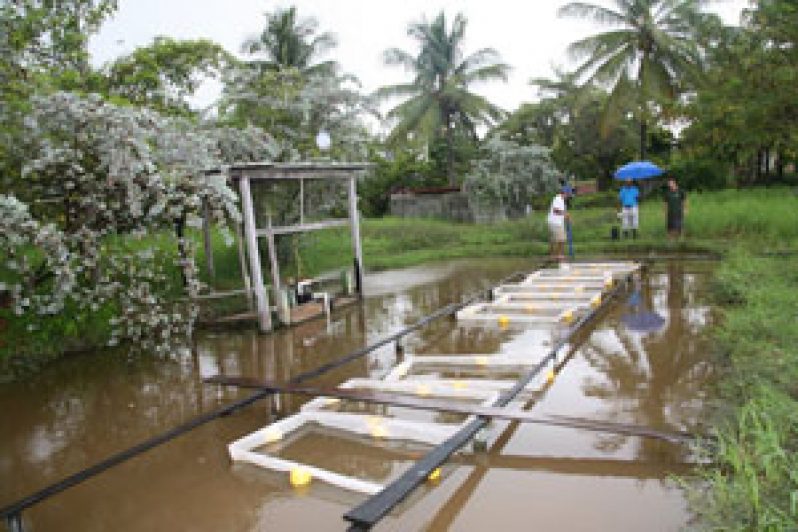A WORKING group on aquaculture has mooted the formulation of a Ten Year Strategic Plan to ensure that that sector makes “a significant contribution to the growth of the Guyanese economy.”
 This recommendation was made by the group, chaired by Mr. Denzil Roberts, during a presentation at this year’s National Economic Forum.
This recommendation was made by the group, chaired by Mr. Denzil Roberts, during a presentation at this year’s National Economic Forum.
The group, highlighting that aquaculture has been pegged as a priority sector under the National Competitiveness Strategy, observed that “worldwide aquaculture is [regarded as] the fastest growing sub-sector of agriculture…as demand for aquatic food products is expected to increase.”
Sourcing aquatic food by traditional ‘capture fishing’ will become more difficult, as “globally, production from capture fisheries has levelled off and most of the main fishing areas have reached their maximum potential.” Therefore, aquaculture will be increasingly relied on to produce aquatic food since “sustaining fish supplies from capture fisheries will…not be able to meet the growing global demand for aquatic food.”
“According to FAO projections, it is estimated that in order to maintain the current level of per capita consumption, global aquaculture production will need to reach 80 million tonnes by 2050,” the group asserted in its presentation document.
The group pointed out that Guyana’s “abundant natural resources” such as, land space and many rivers position the country to be host to a viable aquaculture sector. In addition, they noted, Guyana has a wide “diversity of freshwater species” of aquatic livestock – including Tilapia, Pacu, Shrimp, Hassar, Queriman, mullet and Bashaw – that could be reared. Meanwhile, the group reasons that there exists a strong local market for aquatic food as the average Guyanese eats some 58 kilogrammes of it annually.
The strong presence of the fish-and-shrimp loving Brazilians and Chinese here also strengthens the domestic demand, the group adds, even as it pointed out that vibrant overseas markets also exist in the Caribbean, Brazil and Suriname. The group says that a programme for market research and promotion for the exportable species should be developed and implemented.
According to the group, there is willingness on the part of the government to move the sector forward, with fiscal incentives being offered investors through investment promotion agency, GO-INVEST. Additionally, the IDB-funded Agriculture Export Diversification programme, and the Guyana Trade and Investment Support initiative financed by USAID are in place to promote aquaculture.
Despite the bright prospects for aquaculture, however, the group points out that “progress has been slow.” According to the group, aquaculture output peaked at 511 metric tons, with production averaging 400 metric tons per annum.
It indicated that the constraints to aquaculture here are “quite similar” to those in the region. Among these, it iterates, are the “the lack of credit facilities for initial capital investments or expansion, as well as for operations.” To boost credit to current and prospective aquaculture entrepreneurs, the group wants “an incentive regime for the commercial banks similar to that of the housing sector.” The corporate tax paid by banks on income earned on mortgages was slashed by government, in order to reduce mortgage lending rates.
The high cost of imported feed, which account for between 60 to 80 percent of operating costs, and the accompanying lack of a cheaper local substitute worsen matters, the group says. In response, the group urges the initiating of bulk buying of feed to reduce costs. It recommends, too, that the feeding trials of duckweed, underway at the Satyadeow Sawh Aquaculture Station, be given priority.
The group also bemoaned the weak institutional capacity for research, technology development, training and extension. It notes that this points to the need for “capable laboratories” which can also be used to conduct testing cheaply to ensure that aquatic food products meet the sanitary requirements of importing countries.
The group is also calling for producer associations that are “established, strengthened and well organised”, to represent the sector in its engagement with the government. Further promoting this cluster approach to aquaculture, the group urged the establishment of aquaculture parks, which are similar to industrial parks, and allow individual aqua-culturists to benefit from sharing basic operational costs, such as utilities and water treatment.
In their presentation, the group warned that erratic weather patterns associated with climate change would lead, variably, to an excess or scarcity of water. The issue of praedial larceny is also of concern, the group adds.



.jpg)








